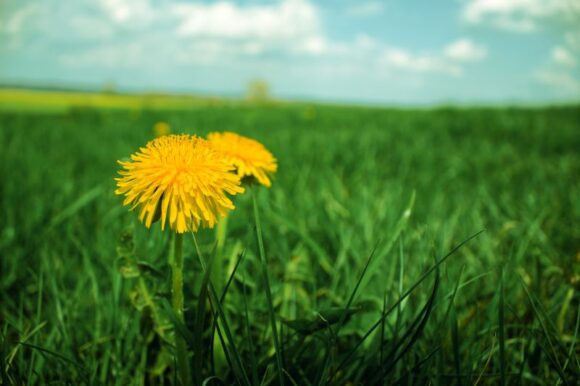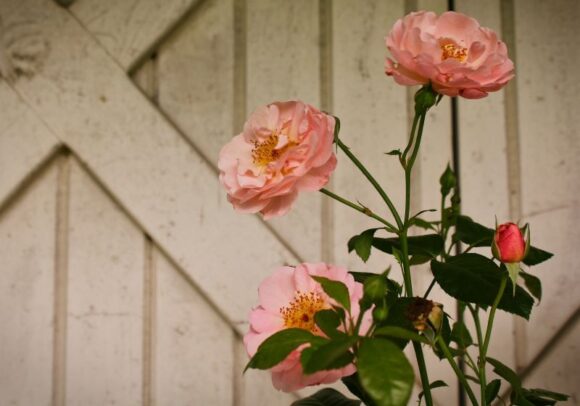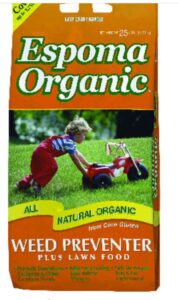
Those April showers that come our way
They bring the flowers that bloom in May
And when it’s raining, lets not forget,
It isn’t raining rain at all, its raining violets
April is the month of activity in the garden, and our old nemesis, the weeds, are beginning to rear their heads, so before we actually begin to extract the little devils before they get too large or strong, I feel that I must point out the benefits of many weeds.
Nettle, for example, are food for butterflies, clover extracts nitrogen from the air and fixes it in the soil and oil from jewel weed soothes poison ivy rash. Whilst the young foliage of dandelions is great in salads and when cooked tastes like spinach and is healthy as it contains many nutrients. Not to forget to mention that our songbirds and other wildlife depend on weed seeds as a food source.
But let us return to the actual weed-pulling, weeds must be pulled gently so the weed and roots do not break for when this happens thousands of weed seeds will reseed and you will find yourself with an endless cycle of unnecessary weeding. When careful weeding has been accomplished I suggest applying an organic weed pre-emergent, with a corn gluten base by Bradfield organics.
ROSES

Plant bare root roses at the end of April and container roses in mid May. Add manure with a fine bark mulch about one foot from the base of the roses not now but in the middle of May. Check my March tips to refresh yourself on pruning roses.
Be careful clearing winter debris from around rhododendrons, mountain laurel and azaleas, these evergreens have shallow roots and you do not want to chance the roots being exposed. If the winter weather did indeed erode soil around any roots, add a few inches of soil to cover the exposed roots, at the same time resettle the plant in place and apply manure and fine bark mulch as well as some peat, which evergreens enjoy at the beginning of May.
In late April, plant gladioli corms at two-week intervals so that you will get a succession of bloom. Planting the corms eight inches down; the extra depth helps keep the heavy blooms erect.
The Red Lily beetle is rearing its ugly head therefore I suggest applying organic Neem oil on the Lilies when they are about four inches above ground to help prevent and deal with this infestation.
SOIL SOLARIZATION
This is an effective way to control many soil borne problems, specifically the tomato blight that causes fruit rot. Covering the soil with clear plastic at the end of April, for one to two months can generate high enough temperatures in the top six to 12 inches of soil to kill pests, nematodes, weed seeds and many disease organisms like the tomato blight. This process has proved invaluable for home gardeners and the beneficial effects seem to last for several seasons.
To solarize, dig a trench several inches deep around the bed, and spread a thin, clear plastic film (1-4mils) over the bed. Press the plastic into close contact with the soil and seal the edges by filling the trench with soil.
MAINTAINING AN ORGANIC GARDEN
I urge you to throw away any pesticides and herbicides; they have the same effect as second hand smoke on you, your children and pets. I am covering the state with my lecture on Garden Earth to reconnect people’s hearts, hands and minds with the nourishing energy of Mother Nature’s Life giving gardens.
I am teaching people how to create a beautiful landscape but more important how to maintain it organically. That has always been the philosophy of my family’s heritage in landscaping and the same modus operandii is carried through in our company. Check ‘what to use in the garden ‘ on this website for all organic product sources.
Manure all the borders with composted manure in bags from the garden center or aged manure from the bottom of the farmer’s pile. Mulch with a fine brown hardwood mulch, and in the vegetable garden when it comes time to mulch, mulch with manure which will not ‘cap’, meaning it does not form a crust like other mulches and therefore air and water can get through to the roots of the plants where it is needed.
If you did not apply an organic grub control on the grass in March, apply now to keep the grubs down and cut down on the mole population.
The soil is the most important component of the growing business; compost, organic manure and peat amend the soil to rebuild its structure. The ratio is one part compost to three parts manure and applies peat to the planting mix in the ratio of one part peat to three parts manure when planting evergreens.
Good soil structure assists with drainage, prevents compaction, and the rich nutrients that is the result as these amendments break down encourage the soil animals beneath the surface to work at full capacity. In a light soil such as sand, humus binds the sand particles together and in heavy soil such as clay it keeps the clay particles apart making room for air and drainage. Other humus forming materials are leaves and seaweed tea which we will have for sale in the two few weeks has a root growth hormone, which assists plants to form a strong root system.
Conditions in April are very favorable for new plant-root development, so with this in mind, transplant evergreen shrubs and new evergreens can be planted at the end of April. With the organic manure and peat with the topsoil in the planting hole in the ratios I mentioned above. Give the roots a work out before planting to release them and open them up so the roots will reach into the surrounding soil for nutrients and water and will not dry out in the heat of summer.
 Organic fertilizer contains blood meal, bone meal, seaweed, poultry litter and natural grains. The bulky organic amendments mentioned above must be incorporated into the soil to improve soil texture and structure and many of the necessary nutrients to plants.
Organic fertilizer contains blood meal, bone meal, seaweed, poultry litter and natural grains. The bulky organic amendments mentioned above must be incorporated into the soil to improve soil texture and structure and many of the necessary nutrients to plants.
Before and a month after you have applied the bulky amendments of manure and compost, test the soil to see if there are still some nutrient deficiencies, particularly in clay soil and correct these with some organic fertilizers. Its always better to under fertilize so go sparingly but do not be cheap with the bulk amendments.
When I moved into my farmhouse on the shore 14 years ago, I found soil that was sandy, which is good for drainage but without nutrients. I began adding a few inches of manure to all planted borders in April, July and October and today when I put a spade in the ground to check the color of the soil in spring, it’s ‘black gold’.
If you have used chemical fertilizers in the past, many of the soil organisms that play such an important role in maintaining natural fertility will have died off.
The major plant nutrients are nitrogen (N), which promotes healthy leaf growth, phosphorus (P) for healthy root growth, and potassium for flower development and ripening wood. Other important nutrients are required such as sulphur, magnesium, calcium, boron and iron, but in lesser amounts. The organic fertilizer provides all the important nutrients listed above. When buying the products read the labels — if there is a word you cannot pronounce; it’s a chemical so do not buy it.
The amendments and organic fertilizers are of plant and animal origin so gloves should be worn when using them as bacteria is present in them. These bacteria are great for the plants and the soil but not good for your health. These products tend to be slow acting; gradually making the nutrients available to the plant and the rewards are infinite.
Organic fertilizers are applied in spring around mid to late May when the plant has about six inches of growth; this allows for the fertilizer to become active when the plant is growing most rapidly. Avoid applying fertilizers after the end of July as new growth may not go dormant before winter and the plant could suffer damage.
As well as the amendments of organic aged manure, peat and/or compost you can incorporate an organic root development enhancer like the seaweed tea by soaking the top four inches of the soil around the base of the trunk when planting trees and shrubs. Top dressing organic fertilizers are scattered over the soil surface and around the base of the plant, avoiding the foliage.
Organic soil enhancers like manure and seaweed tea, when applied to the soil, are most quickly absorbed by plants and are especially useful for container planting and these teas are excellent for feeding throughout the growing season. Foliar (aka leaf) feeds with the teas are a quick-acting tonic and are useful in supplying nutrients to plants especially in the heat and humidity of mid summer.
April is the time to tackle a new lawn or patch seed, use only good quality seed and organic fertilizers.
DAFFODILS
The daffodils will soon be in bloom and when the bloom has past, do not cut the leaves of any of your spring flowering bulbs, the leaves send down energy into the bulbs to store for next season’s nutrition.
WHEN TO PLANT ANNUALS
Do not be lulled into complacency with a few back-to-back warm days; we can still get a frost and I caution you not to plant annuals until Memorial weekend. Do not cultivate around the perennials in the borders until mid May. Do not panic if you were not able to get the April tasks done until May, your garden will wait for you and the constancy that is Mother Nature will continue to keep your patch of earth flourishing.
Enjoy the pleasure of being outdoors in warmer temperatures, inhaling the pungency of awakening soil and experience the connection with growing things. Do not overdo it; warm up the body before the garden labor and stay well hydrated with lots of water. We are inexorably entwined with the earth and know that even the smallest gesture of a garden has positive rewards and the effects not only on you but our planet.
I’ll see you in your garden in May.
Contact Maureen at maureenhaseleyjones@gmail.com

About the author: Maureen Haseley-Jones, pictured left, is a member of a family of renowned horticultural artisans, whose landscaping heritage dates back to the 17th century. She is one of the founders, together with her son Ian, of, ‘The English Lady Landscape and Home Company.’ Maureen and Ian are landscape designers and garden experts, who believe that everyone deserves to live in an eco-conscious environment and enjoy the pleasure that it brings. Maureen learned her design skills from both her mother and grandmother, and honed her horticultural and construction skills while working in the family nursery and landscape business in the U.K. Her formal horticultural training was undertaken at the Royal Botanic Gardens at Kew in Surrey.